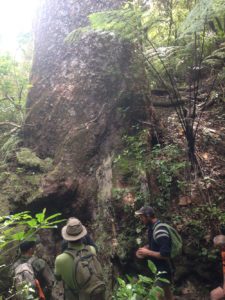Disease infected kauri on the Kiwi Coast are dying and there is no cure.
 However, this weeks NZ Landcare Trust Kauri Dieback Workshops hosted by Manaia Landcare and led by Dr Karen Verdurmen helped some of the Kiwi Coast groups learn some practical steps to prevent the disease from spreading and infecting further kauri.
However, this weeks NZ Landcare Trust Kauri Dieback Workshops hosted by Manaia Landcare and led by Dr Karen Verdurmen helped some of the Kiwi Coast groups learn some practical steps to prevent the disease from spreading and infecting further kauri.
The NZ Landcare Trust brought together a raft of Northland Landcare Groups and projects to help share knowledge and understanding of the kauri killing disease, practical ways to prevent it spreading and infecting further kauri, and how to keep vital pest control operations going – even in infected stands.
The workshops were led by Dr Karen Verdurmen who has spent the last 3 years walking with landowners, communities, iwi and hapu through kauri stands in Northland, Auckland and the Waikato. Visiting kauri stands with those caring for them both helps Karen to share her knowledge as well as learn from people on-the-ground about their experiences and what they have seen develop over the last few years.
Karen says: “My aim is to assist the people that dedicate their efforts to the wellbeing of the bush. The solution to stopping the spread of Kauri Dieback on the ground, is and always will be, a site specific, people specific and activity related specific solution”.
The practical Kauri Dieback Workshops were hosted by Manaia Landcare on the Whangarei Heads peninsula. Frank Bates and Mike Lee from the group were on hand at the beginning of each workshop to share insights on Manaia Landcare’s pest control work and how this as been effected by presence of Kauri Dieback disease in a number of kauri stands.
Martin Hunt, coordinator of the Manaia Landcare Group, says: “At first we didn’t want to hear that our kauri were infected – it was devastating. But we had to overcome our fears and start working out how we were going to keep pest control going. Without it, the forest was going to slowly die from pests anyway. With Karen’s help, we’ve now developed a simple, but effective way forward.”
Workshop participants walked traplines on Mt Manaia that traversed several infected kauri stands and learnt vital information about Kauri Dieback Disease, the Kauri Dieback Programme and basic Kauri Dieback hygiene procedures.
Ngaire Tyson, from the NZ Landcare Trust and Kiwi Coast says: “It was particularly sobering to stand in front of massive kauri trees that were oozing sap from the base of their trunks as they fought their losing battle with Kauri Dieback Disease. Learning from Karen to how recognise symptoms of the disease and prevent it’s spread was empowering.“
Those on the workshop learnt how to recognise symptoms exhibited by kauri with the disease from both a ridgeline away, as well as during a close up inspection. The innovative Manaia Landcare boot-cover system meant that participants also learnt how to move in and out of kauri stands without moving soil and spreading the disease.
Dr Verdurmen says “Kauri Dieback Disease lives in the soil and can be spread by just a pinprick of dirt on your boot. Preventing the movement of soil within and between kauri stands will help prevent the spread of the disease and keep kauri stands safe”.
The workshops held by the NZ Landcare Trust over two days were aimed at community group leaders on Day 1 and professional predators trappers on Day 2. The community-group leaders shared concerns about public use of forests in their project areas that may be unaware of the need to prevent the spread of Kauri Dieback, how to manage contractors who move between sites and how to help private landowners worried that kauri on their land may be infected.
The professional predator trappers, who often work with more than one group to tackle the tricky job of keeping predators low enough so kiwi can nest and roam in safety, were keen to learn how to effectively clean their gear between sites, trial the booties and report in any suspect trees encountered when carrying out their trapping.
Community-led projects involved in the workshop included Whananaki Landcare, Whareora Landcare, Owhiwa Landcare, Tapuhi Landcare, Manaia Landcare, Riverlands Landcare and Reotahi Landcare. Professional trappers attending the workshop included contractors for the Department of Conservation, Kaimamaku Landcare, Whananaki Landcare, Pukenui Forest Trust, Tutukaka Landcare Coalition, Sandy Bay Kiwi, Taheke Landcare, Waipu, Pataua North Landcare, Owhiwa Landcare, Whareora Landcare, Ngunguru Ford Landcare, and the Hancock Forest Management ‘Whanui’ Project.
More information on Kauri Dieback Disease in Northland…



